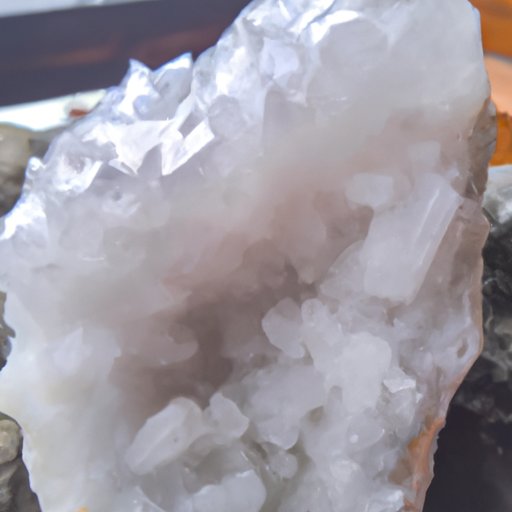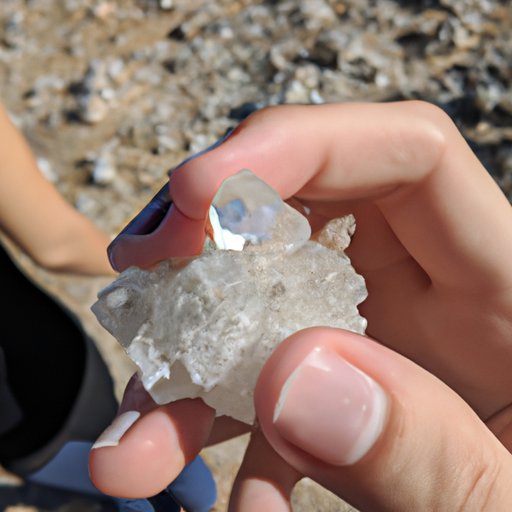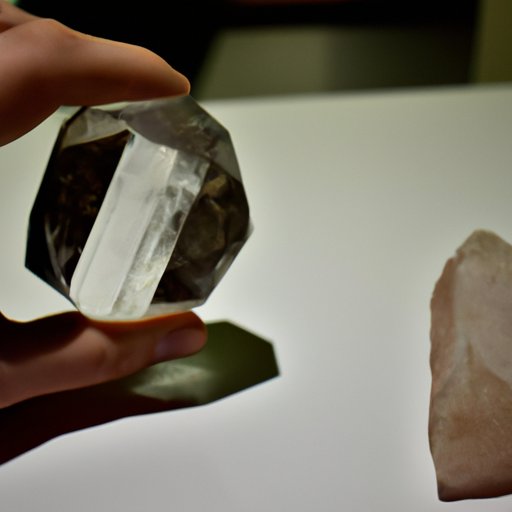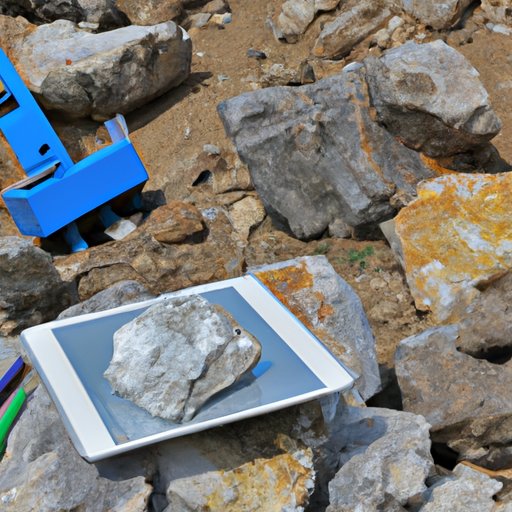Introduction
Quartz and rocks are two important components of Earth’s geology. But is quartz a mineral or a rock? To answer this question, we need to explore the physical, chemical, and environmental properties of quartz and rocks. In this article, we will compare the physical properties of quartz and rocks, examine their chemical composition, explore the geological origins of quartz and rocks, investigate how quartz is used in everyday life, analyze the role of quartz in history and culture, and evaluate the environmental impact of mining quartz and rocks.

Definition of Quartz and Rocks
Quartz is one of the most abundant minerals on Earth. It is composed of silicon dioxide (SiO2) and has a glassy luster. It is usually found in the form of crystal clusters, which can range in color from transparent to opaque. Quartz can also be found as a powdery substance or in the form of veins and masses.
Rocks are solid aggregates of minerals, organic matter, and other materials. They are classified into three major categories: sedimentary rocks, igneous rocks, and metamorphic rocks. Sedimentary rocks are formed from the accumulation of sediments, such as sandstone, shale, and limestone. Igneous rocks are formed by the cooling and crystallization of magma, such as granite and basalt. Metamorphic rocks are formed when existing rocks are subjected to extreme heat and pressure, such as marble and slate.
Comparing the Physical Properties of Quartz and Rocks
The physical properties of quartz and rocks vary depending on the type of quartz and rock. Here are some of the common physical properties of both quartz and rocks:
Color
Quartz comes in a variety of colors, including clear, white, pink, purple, gray, and black. Rocks can also come in a variety of colors, depending on the type of rock. For example, granite is typically gray or pink, while basalt is usually black.
Hardness
Quartz is considered to be a very hard mineral, with a Mohs hardness rating of 7. Rocks can have a wide range of hardness ratings, depending on the type of rock. Granite, for example, has a Mohs hardness rating of 6-7, while limestone has a Mohs hardness rating of 3-4.
Crystal Structure
Quartz has a hexagonal crystal structure, meaning it is composed of six-sided crystals. Rocks do not have a specific crystal structure, as they are composed of many different minerals, organic matter, and other materials.
Examining the Chemical Composition of Quartz and Rocks
The chemical composition of quartz and rocks varies depending on the type of quartz and rock. Here are some of the common chemical elements in quartz and rocks:
Chemical Elements in Quartz
Quartz is composed primarily of silicon dioxide (SiO2). It may also contain trace amounts of other elements, such as aluminum, calcium, iron, magnesium, potassium, sodium, and titanium.
Chemical Elements in Rocks
Rocks are composed of various minerals, organic matter, and other materials. The exact composition of a particular rock depends on the type of rock. For example, granite is composed primarily of quartz, feldspar, mica, and other minerals, while limestone is composed primarily of calcite and other minerals.

Exploring the Geological Origins of Quartz and Rocks
The geological origins of quartz and rocks vary depending on the type of quartz and rock. Here is an overview of the formation of quartz and rocks:
Formation of Quartz
Quartz is formed through the crystallization of molten magma. As the magma cools and solidifies, the ions of silicon and oxygen combine to form quartz crystals.
Formation of Rocks
Rocks are formed through the combination of heat, pressure, and time. For example, sedimentary rocks are formed from the accumulation of sediments over time, while metamorphic rocks are formed when existing rocks are subjected to extreme heat and pressure.
Investigating How Quartz is Used in Everyday Life
Quartz is used in a variety of ways in everyday life. Here are some of the common uses of quartz:
Jewelry
Quartz is often used in jewelry due to its hardness and sparkling appearance. Quartz is commonly used in rings, earrings, necklaces, and bracelets.
Sculpture
Due to its hardness and ability to take a fine polish, quartz is often used in sculpture. Quartz sculptures can range from small figurines to large monuments.
Construction Materials
Quartz is also used in construction materials, such as tiles, countertops, and flooring. Quartz is often used in high-end homes and businesses due to its durability and aesthetic appeal.

Analyzing the Role of Quartz in History and Culture
Quartz has played an important role in history and culture throughout the ages. Here are some of the ways that quartz has been used in history and culture:
Religious Significance
Quartz has long been associated with religious and spiritual beliefs. For example, quartz has been used in various religious ceremonies and rituals, such as Native American sweat lodges. Quartz has also been used as a talisman or amulet to ward off evil spirits.
Historical Uses
Quartz has also been used for practical purposes throughout history. For example, quartz was used to make tools and weapons, such as arrowheads and spear tips. Quartz was also used in early clocks and watches.

Evaluating the Environmental Impact of Mining Quartz and Rocks
Mining quartz and rocks can have a significant environmental impact. Here are some of the potential effects of mining quartz and rocks:
Pollution
Mining operations can release pollutants into the air, water, and soil. These pollutants can include heavy metals, dust, and other hazardous substances. This pollution can have adverse effects on human health and the environment.
Habitat Destruction
Mining operations can also cause habitat destruction. These operations can remove vegetation, disrupt ecosystems, and cause soil erosion. This can lead to the displacement of animal and plant species, as well as the destruction of natural habitats.
Conclusion
In conclusion, quartz is a mineral composed of silicon dioxide, while rocks are solid aggregates of minerals, organic matter, and other materials. Quartz and rocks have different physical and chemical properties, and are formed through different geological processes. Quartz is used in a variety of ways in everyday life, and has played an important role in history and culture. Mining quartz and rocks can have a significant environmental impact, including pollution and habitat destruction. Therefore, it can be concluded that quartz is a mineral, not a rock.
(Note: Is this article not meeting your expectations? Do you have knowledge or insights to share? Unlock new opportunities and expand your reach by joining our authors team. Click Registration to join us and share your expertise with our readers.)
